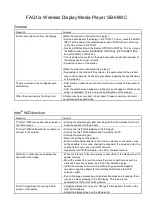
48
Program
loaded "Update DCC taught and Märklin® at the current Central Station 2
followed suit, this issue has clearly defused: All current mfx® centers speak DCC
and can program DCC decoders. But since all LokSound dominate 5 Decoder
DCC, you can now choose how you want to program the decoder:
• The Central Station ® 60212 Reloaded, Central Station 2 and Station 3 Central
offer a graphic programming option for M4 decoder. This of course "knows" only
the "old" ESU LokSound V3.5 and their capabilities, and the DAR to ajar, barely
changed Marklin decoder. easily programmed through this menu advertising
LokSound decoder 5 can. However, some options are not available because the
center they do not "know".
In particular, the change of function key assignments (mapping) is not
possible. Here is necessary to resort to the DCC programming. Also, the
menus in the Central Station ® are locked.
• You can access functions at any time via DCC programming to all Op. If you
have an ESU ECoS, we recommend this type of access. This center also brings
a fitting de- coderprofil with the decoder.
8.1.2. M4, the mfx® compatible protocol by ESU
In introducing the mfx® data protocol, the goods were signs by Märklin®
protected. Therefore ESU uses the term M4 for all decoders that use this data
format, from January of 2009. M4 is technically 100% compatible with mfx®. All
ESU decoders and Central, which dominate M4 can be easily combined with the
corresponding Märklin mfx® products. We apologize for this, unavoidable for
legal reasons conceptual chaos.
8.1.3. Configuration variable (CVs)
The sound decoders follow the CV created in the USA. The name CV (
"Configuration Variable") derives from the fact that the storage cells described
above are not only variable, but also the behavior of the decoder con- figuring.
8.1.3.1. Standardization in NMRA
The NMRA (National Model Railroad Association) has placed fixed, right through
which CVs loading parameters of a decoder is. The DCC norm denotes the CVs
fixed with numbers, the most important are specified binding. This makes the
handling of CVs is simplified for the user, since decoder unterschiedlichster
manufacturers of these standards follow the ER and got to deal with CVs can be
applied the same everywhere. In the DCC CV concept number values from 0
can be written in the CVs to the 255th Each CV carries only one number. While
the position (CV number) is specified, the range of values can vary quite. Not all
CVs must accept values from 0 to 255th
In the list of CVs in Chapter 21, which allowed for sound decoders values are
shown.
8.1.3.2. Bits and bytes
The most CVs contain numbers: CV 1 beispiels- example includes the
locomotive address. . This can be between 1 - 127 Lie gen So while most CVs
expect numerical values, other CVs are more likely to be understood as a
collection of different "switches" that manage various functions together (usually
on or off): Good examples of this are the CVs 29 and 49: for those of CVs
provided for the CV value must be calculated itself. This depends on the desired
attitudes from:
Check out in the table in Chapter 21, the explanations for CV 29: First, decide
which switched on the options or to be turned off. In the Value column STE hen
two numbers for each option. If the option is disabled
Summary of Contents for 58315
Page 104: ...104 notes...
Page 105: ...105 notes...
Page 109: ...109 notes...
Page 110: ...110 notes...
Page 111: ...111...
















































